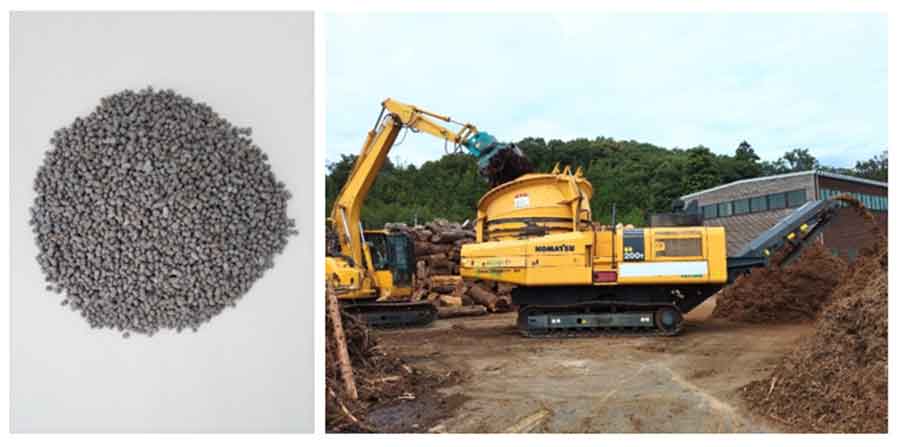Komatsu Successfully Converts Biomass Combustion Ash Into Fertilizer In Japan
Komatsu Ltd. jointly with Ishikawa Agriculture and Forestry Research Center and ASAHI AGRIA CO., LTD., a manufacturer of fertilizers, has successfully converted wood ash from the biomass boilers in operation at Komatsu’s Awazu plant in the Kaga area of Ishikawa Prefecture. As a leading model of the public-private sector partnership, the three partners will contribute to the reduction of industrial waste and achievement of carbon neutrality by developing the circulation cycle which extends to agriculture and forestry and the vitalization of agriculture and forestry in Ishikawa Prefecture by using biomass combustion ash as fertilizer.
In 2014, Komatsu reached a comprehensive forestry agreement with the Ishikawa prefectural government and the Federation of Forestry Associations of Ishikawa Prefecture to jointly promote the vitalization of local forestry. At its Awazu plant, since 2015, Komatsu has operated biomass boilers using fuel chips from thinnings in the Kaga area. Using about 6,000 tons of woodchips annually, Komatsu contributes to promoting sound management of forests and curbing driftwood-caused damages after heavy rain. Meanwhile, Komatsu has disposed of about 20 tons of wood ash generated in the biomass boilers as industrial waste, which has been an issue of concern for the Awazu plant.
After focusing attention on potassium and phosphorus, necessary nutrients of agricultural products contained in regular wood ash, at the Awazu plant, since June 2016, Komatsu has worked with two new partners: the Ishikawa Agriculture and Forestry Research Center and ASAHI AGRIA. Work has centered on content analysis of wood ash generated in the biomass boilers at the Plant and on the verification of fertilizing effects with an eye to converting wood ash to fertilizer. These efforts have found a sufficient amount of active ingredients of fertilizer, including potassium. Cultivation tests have also demonstrated no difference from conventional fertilizers.

Left: Prototype fertilizer made from biomass combustion ash. Right: Mixed crushing at KAGA FOREST ASSOCIATION.
In August 2017, Komatsu applied for “applications for registration of fertilizer” as biomass combustion ash-based fertilizer with the Ministry of Agriculture, Forestry and Fisheries. Japan has relied on imports of potassium and phosphorus as raw fertilizer materials. Recently, however, safe wood ash, generated mainly in biomass boilers, has attracted keen attention as an alternative raw material accessible in Japan. Against this background, the Japanese government enforced the revised Act on the Quality Control of Fertilizer in the previous fiscal year, which promoted the classification reassessment of fertilizers. Safety-verified wood ash is now classified as a “byproduct fertilizer.” Awazu plant’s biomass combustion ash was registered as byproduct fertilizer in April 2022.
Also in April, Komatsu began delivery of Awazu plant’s biomass combustion ash as raw fertilizer material to ASAHI AGRIA’s Kansai plant. Komatsu plans to deliver almost all of Awazu’s ash there. Currently, the partner plant is busy preparing for the production start-up of fertilizer which uses biomass combustion ash. ASAHI AGRIA is working on launching sales of the fertilizer through the JA Group, the group of Japan agricultural cooperatives, and other sales channels, starting in FY2023.
Latest news
UK Government Signs Contract With Drax
UK Government Signs Contract With DraxDrax confirms it has signed a contract with the UK Government for a low-carbon dispatchable CfD (Contract for Difference) agreement to cover all four biomass units at Drax Power Station over the period April 2027 to March 2031....
Biomass Plant Coming To South Carolina
Biomass Plant Coming To South CarolinaStartup company Carolina Renewable Products recently announced a new biofuel plant to be located near Orangeburg, SC. The company’s $280 million investment will create 155 new jobs. The company plans to convert sustainable woody...
Find Us On Social
Subscribe to Our Newsletter
Wood Bioenergy News Online hits the inboxes of subscribers in the wood-to-energy sectors.
Subscribe/Renew
Wood Bioenergy is published and delivered worldwide 6 times per year. Free to qualified readers in the U.S. Subscribers outside the U.S. are asked to pay a small fee.
Advertise
Complete the online form so we can direct you to the appropriate Sales Representative.
